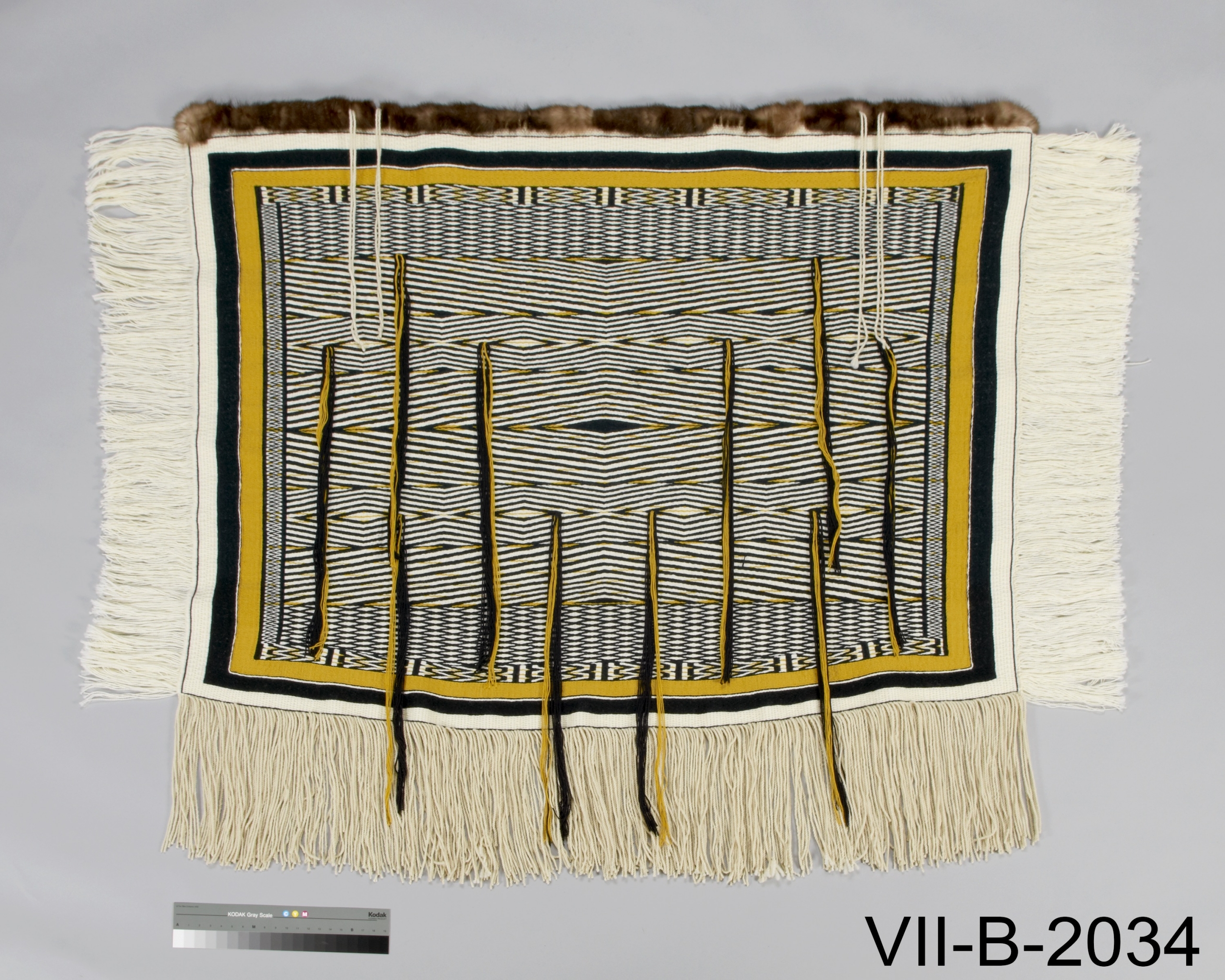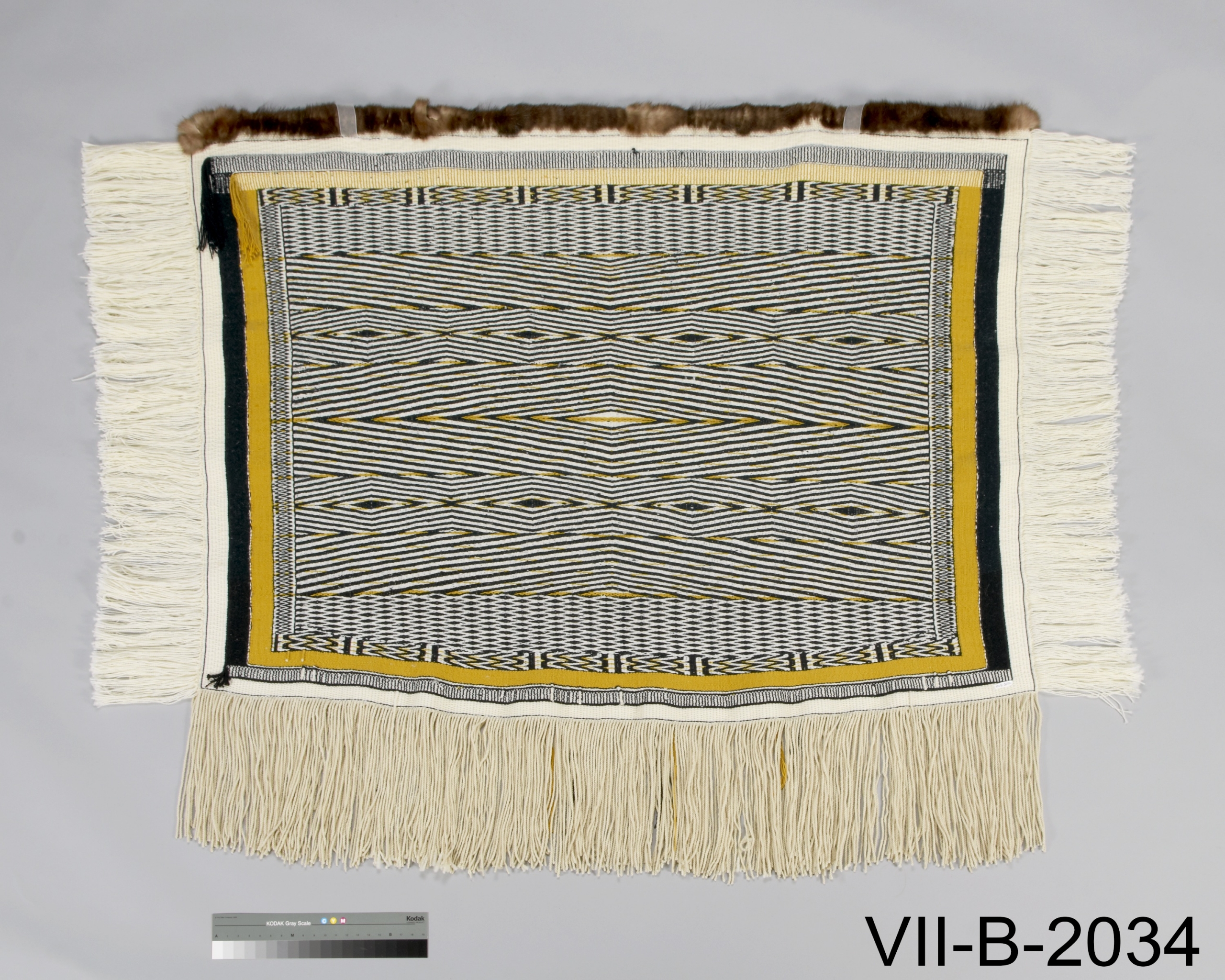Raven’s Tail Ceremonial Robe, Sqalra Qwii Ghaalgyaat (Ripples in the Sky)
Artifact
Image
Video
Audio
 Activities
Activities
THINK
This gyáat’aad (robe) was made in 2011, but it demonstrates traditional Raven’s Tail weaving techniques that have been passed down from mother to daughter for generations. Why do you think it’s important that ginn xay ‘léeygaa (Haida weavers) continue to use these ancestral techniques? What might be lost if they didn’t?
LOOK
Look at the designs on this Raven’s Tail gyáat’aad (robe). Describe the patterns and colours you see. Read the historical context to learn why the patterns and colours are used.
Details
 Materials
Materials - Wool
Historical Context
Choose one of the three levels below to match your needs.
- X̱áaydaa (Haida) artist Kujuul Evelyn Vanderhoop and her two daughters wove this Raven’s Tail gyáat’aad (robe) in 2011. Following traditional practice, weaving skills are still passed down from mother to daughter today.
- Robes like this one are very rare. Only those of a certain social status or wealth, such as chiefs, wear them.
- Raven’s Tail gyáat’aad (robes) are known for their geometric patterns and traditional colours: yellow, white and black.
- The videos on the next slide shows this robe being danced, as well as an interview with Kujuul Evelyn Vanderhoop.
X̱áaydaa (Haida) artist Kujuul Evelyn Vanderhoop and her two daughters wove this Raven’s Tail gyáat’aad (robe) in 2011. Following traditional practice, weaving skills are still passed down from mother to daughter today.
Robes like this one are very rare. Only those of a certain social status or wealth, such as chiefs, wear them on special occasions. Raven’s Tail gyáat’aad (robes) are known for their geometric patterns and traditional yellow, white and black colours. Side fringes and furs are added to complete the robe.
The videos on the next slide shows this robe being danced, as well as an interview with Kujuul Evelyn Vanderhoop.
Kujuul Evelyn Vanderhoop, a well-known X̱áaydaa (Haida) artist, and her daughters K’iinuwaas Carrie-Ann Vanderhoop Bellis and S’idluujaa Tiffany Amber Vanderhoop wove this Raven’s Tail gyáat’aad (robe) in 2011. Robes like this one are highly valued and worn by individuals of high rank or social status. A chief, for example, might wear one for a special occasion such as a potlatch or feast.
Raven’s Tail gyáat’aad (robes) are known for their geometric patterns and traditional yellow, white and black colours, as seen here. Fringes and furs are often added to complete the robe. Traditionally, Kúu (sea otter) fur was used, but now that otters are endangered, beaver fur is more common.
Textile weaving skills are usually passed down from mother to daughter. In this case, Kujuul Evelyn Vanderhoop’s two daughters assisted her in completing the robe. Raven’s Tail weaving is one example of a Haida art form that continues today.
The videos on the next slide shows this robe being danced, as well as an interview with Kujuul Evelyn Vanderhoop.
- X̱áaydaa (Haida) artist Kujuul Evelyn Vanderhoop and her two daughters wove this Raven’s Tail gyáat’aad (robe) in 2011. Following traditional practice, weaving skills are still passed down from mother to daughter today.
- Robes like this one are very rare. Only those of a certain social status or wealth, such as chiefs, wear them.
- Raven’s Tail gyáat’aad (robes) are known for their geometric patterns and traditional colours: yellow, white and black.
- The videos on the next slide shows this robe being danced, as well as an interview with Kujuul Evelyn Vanderhoop.
X̱áaydaa (Haida) artist Kujuul Evelyn Vanderhoop and her two daughters wove this Raven’s Tail gyáat’aad (robe) in 2011. Following traditional practice, weaving skills are still passed down from mother to daughter today.
Robes like this one are very rare. Only those of a certain social status or wealth, such as chiefs, wear them on special occasions. Raven’s Tail gyáat’aad (robes) are known for their geometric patterns and traditional yellow, white and black colours. Side fringes and furs are added to complete the robe.
The videos on the next slide shows this robe being danced, as well as an interview with Kujuul Evelyn Vanderhoop.
Kujuul Evelyn Vanderhoop, a well-known X̱áaydaa (Haida) artist, and her daughters K’iinuwaas Carrie-Ann Vanderhoop Bellis and S’idluujaa Tiffany Amber Vanderhoop wove this Raven’s Tail gyáat’aad (robe) in 2011. Robes like this one are highly valued and worn by individuals of high rank or social status. A chief, for example, might wear one for a special occasion such as a potlatch or feast.
Raven’s Tail gyáat’aad (robes) are known for their geometric patterns and traditional yellow, white and black colours, as seen here. Fringes and furs are often added to complete the robe. Traditionally, Kúu (sea otter) fur was used, but now that otters are endangered, beaver fur is more common.
Textile weaving skills are usually passed down from mother to daughter. In this case, Kujuul Evelyn Vanderhoop’s two daughters assisted her in completing the robe. Raven’s Tail weaving is one example of a Haida art form that continues today.
The videos on the next slide shows this robe being danced, as well as an interview with Kujuul Evelyn Vanderhoop.
Summary
- X̱áaydaa (Haida) artist Kujuul Evelyn Vanderhoop and her two daughters wove this Raven’s Tail gyáat’aad (robe) in 2011. Following traditional practice, weaving skills are still passed down from mother to daughter today.
- Robes like this one are very rare. Only those of a certain social status or wealth, such as chiefs, wear them.
- Raven’s Tail gyáat’aad (robes) are known for their geometric patterns and traditional colours: yellow, white and black.
- The videos on the next slide shows this robe being danced, as well as an interview with Kujuul Evelyn Vanderhoop.
Essential
X̱áaydaa (Haida) artist Kujuul Evelyn Vanderhoop and her two daughters wove this Raven’s Tail gyáat’aad (robe) in 2011. Following traditional practice, weaving skills are still passed down from mother to daughter today.
Robes like this one are very rare. Only those of a certain social status or wealth, such as chiefs, wear them on special occasions. Raven’s Tail gyáat’aad (robes) are known for their geometric patterns and traditional yellow, white and black colours. Side fringes and furs are added to complete the robe.
The videos on the next slide shows this robe being danced, as well as an interview with Kujuul Evelyn Vanderhoop.
In-Depth
Kujuul Evelyn Vanderhoop, a well-known X̱áaydaa (Haida) artist, and her daughters K’iinuwaas Carrie-Ann Vanderhoop Bellis and S’idluujaa Tiffany Amber Vanderhoop wove this Raven’s Tail gyáat’aad (robe) in 2011. Robes like this one are highly valued and worn by individuals of high rank or social status. A chief, for example, might wear one for a special occasion such as a potlatch or feast.
Raven’s Tail gyáat’aad (robes) are known for their geometric patterns and traditional yellow, white and black colours, as seen here. Fringes and furs are often added to complete the robe. Traditionally, Kúu (sea otter) fur was used, but now that otters are endangered, beaver fur is more common.
Textile weaving skills are usually passed down from mother to daughter. In this case, Kujuul Evelyn Vanderhoop’s two daughters assisted her in completing the robe. Raven’s Tail weaving is one example of a Haida art form that continues today.
The videos on the next slide shows this robe being danced, as well as an interview with Kujuul Evelyn Vanderhoop.



